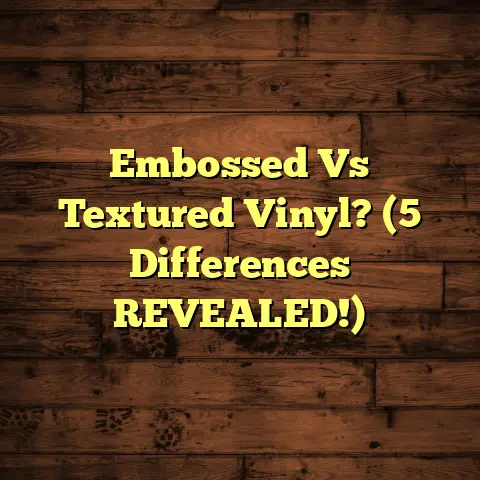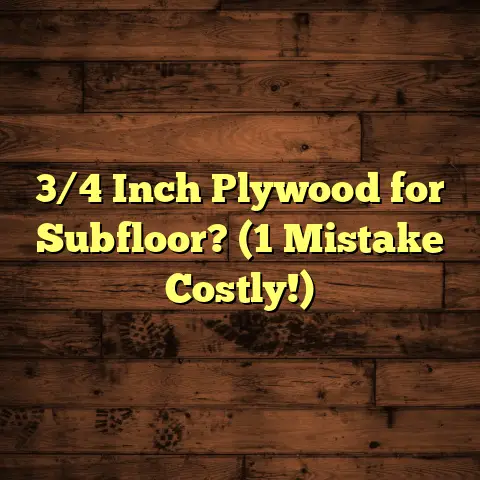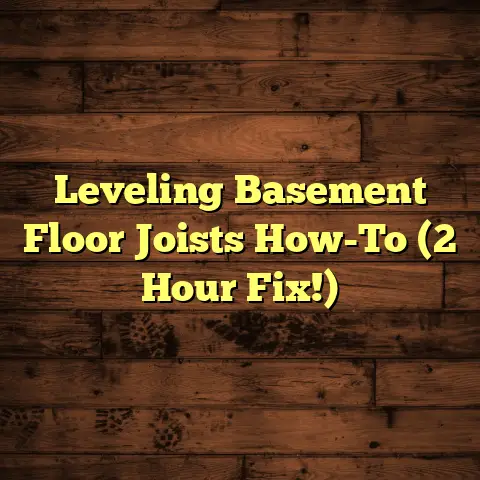Vinyl vs VCT Floor? (1 Key Difference!)
Comfort in flooring goes way beyond just a soft surface. Think about it: warmth on a cold morning, a quieter room thanks to sound absorption, and how easy it is to clean up a spill. These things contribute to the overall comfort and livability of a space.
Today, I want to dive into two popular flooring options: vinyl and VCT (Vinyl Composition Tile). They might seem similar at first glance, but there’s one key difference that can make all the difference in your choice. Let’s explore!
Section 1: Understanding Vinyl Flooring
So, what exactly is vinyl flooring? Simply put, it’s a synthetic flooring made primarily of PVC (polyvinyl chloride) and other compounds. It’s known for being durable, water-resistant, and relatively affordable.
There are several types of vinyl flooring, each with its own unique characteristics:
-
Sheet Vinyl: This comes in large rolls and is great for covering large areas with minimal seams. I’ve installed tons of sheet vinyl in bathrooms and kitchens where water resistance is crucial.
-
Luxury Vinyl Plank (LVP): LVP mimics the look of hardwood planks and is super popular right now. It’s more durable and water-resistant than real wood, making it a fantastic alternative.
-
Luxury Vinyl Tile (LVT): Similar to LVP, but in tile form. LVT can replicate the look of stone, ceramic, or porcelain tiles.
Comfort is Key: One of the biggest advantages of vinyl flooring is its comfort. Many vinyl options have a built-in cushioning layer, making them softer underfoot than harder surfaces like tile or concrete. This is especially important in areas where you spend a lot of time standing, like the kitchen.
Vinyl also provides some degree of insulation, helping to keep your floors warmer in the winter. Plus, it’s a decent sound absorber, reducing noise levels in your home. I’ve had clients tell me how much quieter their homes are after switching to vinyl!
Aesthetic Appeal: Don’t underestimate the aesthetic appeal of vinyl! It comes in a huge range of colors, patterns, and textures. You can find vinyl that looks like real wood, stone, or even abstract designs.
The design versatility is incredible. You can create almost any look you want with vinyl flooring. I’ve even seen custom-printed vinyl used to create unique, personalized floors.
Installation: The installation process for vinyl flooring is generally straightforward, especially for LVP and LVT. Many options are designed for DIY installation, with click-lock systems that make it easy to snap the pieces together.
Proper installation is crucial for comfort. A smooth, level subfloor is essential to prevent bumps or unevenness that can make the floor uncomfortable to walk on. I always recommend taking the time to prep the subfloor properly before installing any type of flooring.
Section 2: Understanding VCT Flooring
Now, let’s talk about VCT flooring. VCT stands for Vinyl Composition Tile. It’s a type of hard flooring made from a mixture of PVC, limestone, pigments, and a binder.
VCT is commonly used in commercial settings like schools, hospitals, and grocery stores. You’ve probably walked on VCT countless times without even realizing it!
Comfort Features (or Lack Thereof): VCT is known for its durability and affordability, but comfort isn’t exactly its strong suit. It’s a hard, inflexible material that doesn’t offer much cushioning or insulation.
Unlike many vinyl options, VCT doesn’t have a built-in cushioning layer. This means it can be quite hard and unforgiving underfoot, especially for extended periods.
However, VCT is extremely durable and can withstand heavy foot traffic. It’s also relatively easy to clean and maintain, which is why it’s so popular in commercial settings.
Aesthetic Appeal: The aesthetic appeal of VCT is more limited compared to vinyl. VCT typically comes in solid colors or simple patterns. While you can create interesting designs by combining different colors, the overall look is generally more utilitarian than decorative.
You won’t find VCT that mimics the look of wood or stone as convincingly as LVP or LVT. VCT is more about function than fashion.
Installation: The installation process for VCT is more involved than for many vinyl options. VCT requires a perfectly smooth and level subfloor. The tiles are typically glued down with a special adhesive, and the seams need to be carefully aligned.
After installation, VCT needs to be sealed and waxed to protect it from dirt and moisture. Regular waxing and buffing are required to maintain its appearance and prevent wear.
The installation process can impact comfort. An uneven subfloor or poorly aligned tiles can create bumps and ridges that make the floor uncomfortable to walk on.
Section 3: The Key Difference Between Vinyl and VCT Flooring
Okay, let’s get to the heart of the matter: the key difference between vinyl and VCT flooring. And that difference, my friends, is comfort.
While both are made of vinyl, the construction is vastly different. Vinyl flooring, especially LVP and LVT, often includes a comfort layer. VCT, on the other hand, is all about durability and cost-effectiveness, often sacrificing comfort.
This difference in comfort has a huge impact on where each type of flooring is typically used. Vinyl is a popular choice for homes because it’s more comfortable, warmer, and quieter than VCT.
VCT is more common in commercial spaces where durability and low cost are the primary concerns. Think about a busy hospital hallway. Comfort isn’t the top priority there; it’s about having a floor that can withstand heavy foot traffic and is easy to clean.
Real-World Examples: I remember one client who had installed VCT in their home to save money. They quickly regretted it because the floor was cold and hard, especially in the winter. They ended up replacing it with LVP, which made a huge difference in the overall comfort of their home.
On the other hand, I’ve worked on commercial projects where VCT was the perfect choice. In a busy retail store, VCT provided the durability and ease of maintenance needed to withstand constant foot traffic and spills.
Comfort impacts user experience in a big way. In a home, a comfortable floor can make a room feel more inviting and relaxing. In a commercial space, a comfortable floor can reduce fatigue for employees who spend long hours on their feet.
Section 4: Comparative Analysis of Comfort in Vinyl vs. VCT
Let’s break down the comfort-related features of vinyl and VCT in a comparison chart:
| Feature | Vinyl Flooring (LVP/LVT) | VCT Flooring |
|---|---|---|
| Cushioning | Often includes a comfort layer | None |
| Warmth | Better insulation | Poor insulation |
| Sound Absorption | Good | Fair |
| Underfoot Feel | Softer | Hard |
| Foot Traffic | Moderate to High | High |
| Climate | Suitable for most climates | Suitable for most climates |
| Intended Use | Residential, light commercial | Commercial, industrial |
As you can see, vinyl flooring generally offers more comfort-related benefits than VCT. The cushioning, warmth, and sound absorption of vinyl make it a more comfortable choice for homes and other spaces where comfort is a priority.
Factors like foot traffic, climate, and intended use can also affect comfort levels. In a high-traffic area, a more durable floor like VCT might be necessary, even if it’s not as comfortable.
In colder climates, the better insulation of vinyl can make a big difference in how warm the floor feels underfoot. And in spaces where people spend a lot of time standing, the cushioning of vinyl can help reduce fatigue.
Industry Insights: I’ve talked to many flooring installers and contractors over the years, and the consensus is clear: vinyl is generally considered more comfortable than VCT.
Many customers have shared their experiences with me, and they often say that switching to vinyl made a noticeable difference in the comfort of their homes.
One customer told me that her back pain improved after switching from tile to LVP in her kitchen. The cushioning of the LVP made it much easier to stand for long periods while cooking.
Another customer said that his kids loved playing on the new vinyl floor in their playroom because it was softer and warmer than the old tile floor.
Section 5: Conclusion
Comfort is a crucial factor to consider when choosing flooring. It affects how a room feels, how comfortable it is to spend time in, and even your overall well-being.
While both vinyl and VCT flooring have their advantages, they differ significantly in terms of comfort. Vinyl flooring, especially LVP and LVT, offers more cushioning, warmth, and sound absorption than VCT.
VCT is a durable and affordable option that’s well-suited for commercial spaces where heavy foot traffic and easy maintenance are the primary concerns.
When choosing between vinyl and VCT, consider your specific needs and environment. If comfort is a priority, vinyl is likely the better choice. If durability and low cost are more important, VCT might be a better fit.
Ultimately, the best flooring choice depends on your individual needs and preferences. Take the time to research your options, consider your budget, and think about how the flooring will impact the comfort and functionality of your space.
I hope this article has helped you understand the key difference between vinyl and VCT flooring. Happy flooring!





